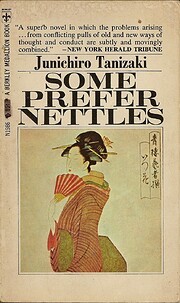

Carregue numa fotografia para ir para os Livros Google.
|
A carregar... Some Prefer Nettles (original 1929; edição 1970)por Junichiro Tanizaki (Autor)
Informação Sobre a ObraSome Prefer Nettles por Jun'ichirō Tanizaki (1929)
 Ainda não há conversas na Discussão sobre este livro.   ) )Marital oddness in late 20’s Japan. Kaname and Misako no longer love each other, but they don’t hate each other either. After 10 years and one kid, all the emotion has leached out of their relationship, leaving an inanimate husk, a replica marriage like the puppets Misako’s father likes to watch. He has a wife 30 years his junior and treats her like a puppet/doll, but she’s no such thing, unlike the preternaturally passive Kaname. Misako’s involved with someone else, but all she and Kaname really care about is how to get divorced with a minimum of upset to their son, her dad, and society in general. The centerpiece of the novel is a fascinating rural puppet show attended, but largely ignored, by all the village, kids playing and peeing while the dwarf-sized, stringless puppets act out their classical tragedies and romances. I loved the final scene too, and the ending (as in The Makioka Sisters) is striking. Similar East-West themes here, too, but the couple’s predicament ultimately seems absurd. A gentle mist dense with metaphors, this story is perfect for dissection in a high school essay. The characters in this unconventional divorce story are not really characters. Instead they are themselves puppets playing out the conflict within Tanizaki, of his growing resistance to newly-introduced western influences and his simultaneous burgeoning appreciation of Japanese aesthetics and traditions. The (translated) prose and story are dreamy and detached, yet loaded with subtext. The story is so deeply rooted in Japanese culture that I'm certain that a lot of the deeper cultural context (beyond what was described in the book) flew over my head (such as the stereotypes of Osakans vs people from Kyoto or Tokyo although I did get a thrill out of getting the simpler references such as the one to the Mitsukoshi lions!) Overall I enjoyed the melancholy aesthetics of it all and the struggle between modernity and tradition. sem críticas | adicionar uma crítica
Pertence à Série da Editora
Junichiro Tanizaki's Some Prefer Nettles is an exquisitely nuanced exploration of the allure of ancient Japanese tradition--and the profound disquiet that accompanied its passing. nbsp; It is the 1920s in Tokyo, and Kaname and his wife Misako are trapped in a parody of a progressive Western marriage. No longer attracted to one another, they have long since stopped sleeping together and Kaname has sanctioned his wife's liaisons with another man. But at the heart of their arrangement lies a sadness that impels Kaname to take refuge in the past, in the serene rituals of the classical puppet theater--and in a growing fixation with his father-in-law's mistress. Some Prefer Nettles is an ethereally suggestive, psychologically complex exploration of the crisis every culture faces as it hurtles headfirst into modernity. Não foram encontradas descrições de bibliotecas. |
Current DiscussionsNenhum(a)Capas populares
 Google Books — A carregar... Google Books — A carregar...GénerosSistema Decimal de Melvil (DDC)895.6344Literature Literature of other languages Asian (east and south east) languages Japanese Japanese fiction 1868–1945 1912–1945Classificação da Biblioteca do Congresso dos EUA (LCC)AvaliaçãoMédia: (3.63) (3.63)
É você?Torne-se num Autor LibraryThing. |
||||||||||||||||||||||||||||||||||||||||||||||||||||||||||||||||||||||||||||||||||||||||||||||||||||||||||||||||||||||||||||||||||||||||